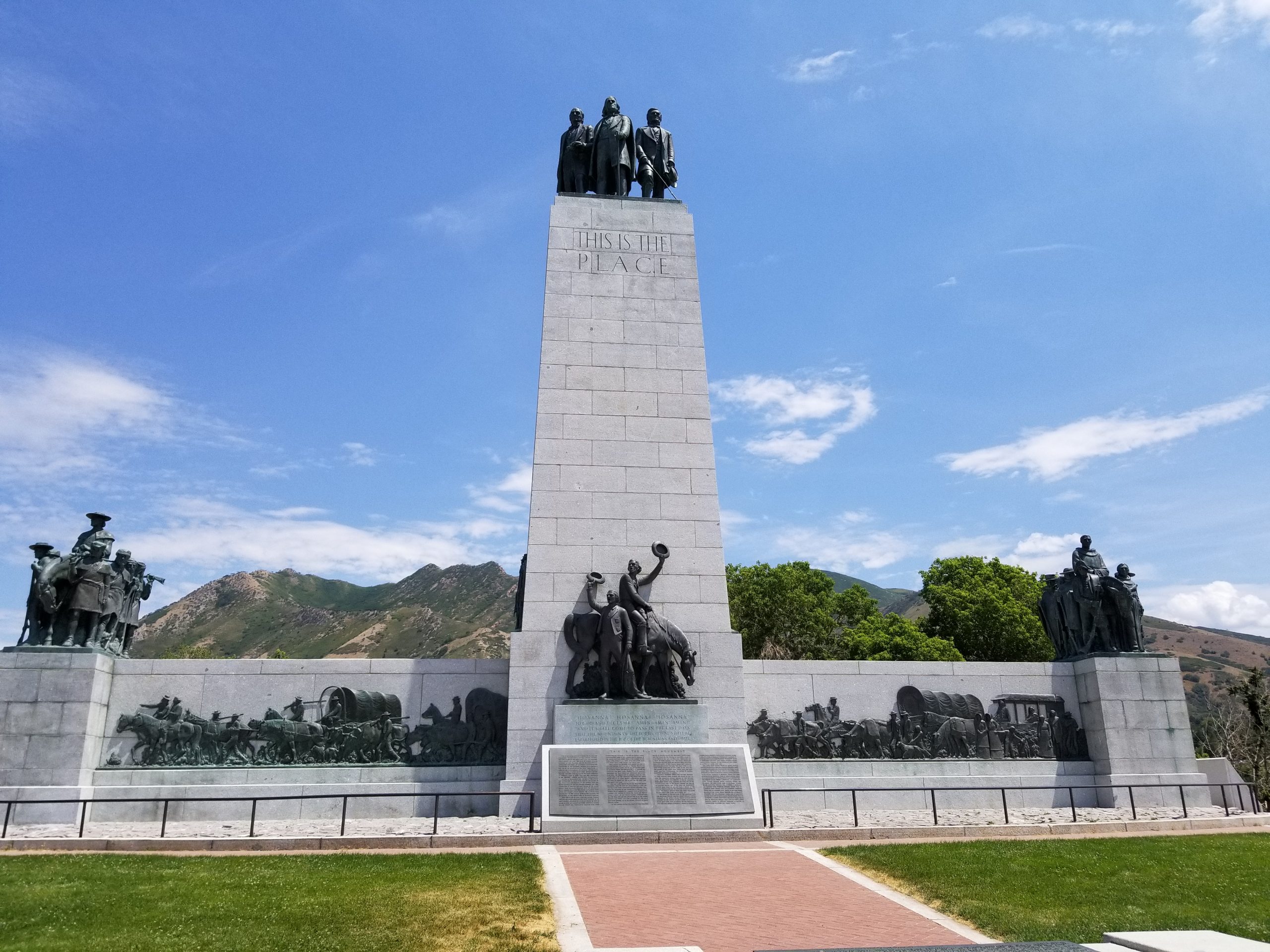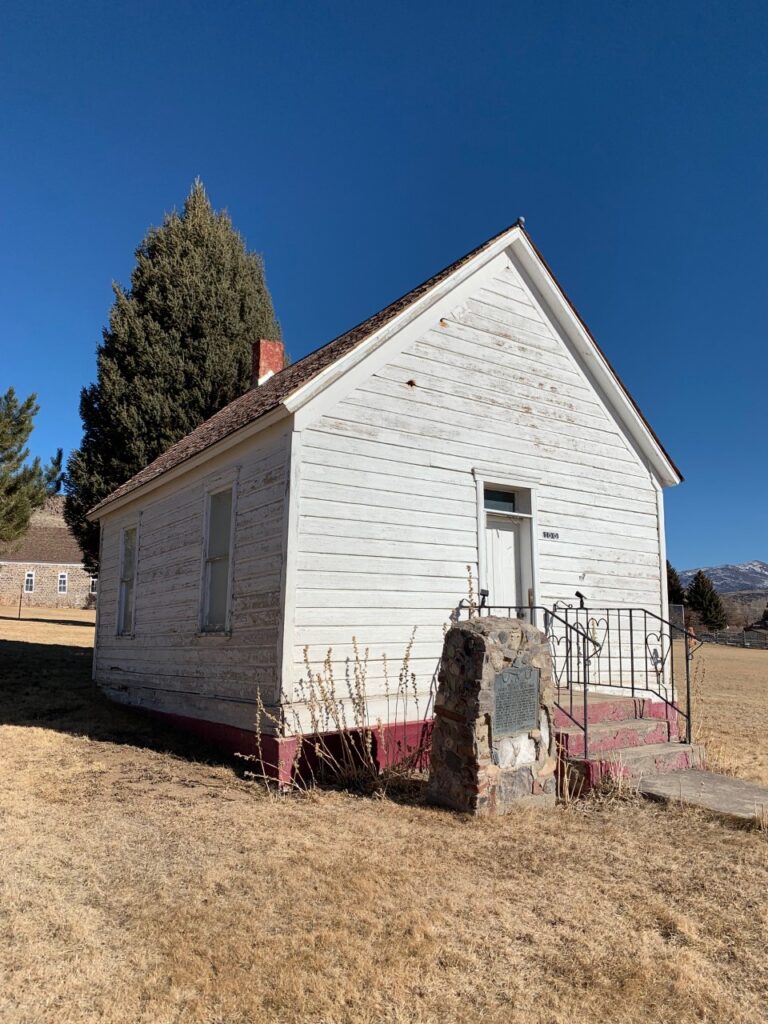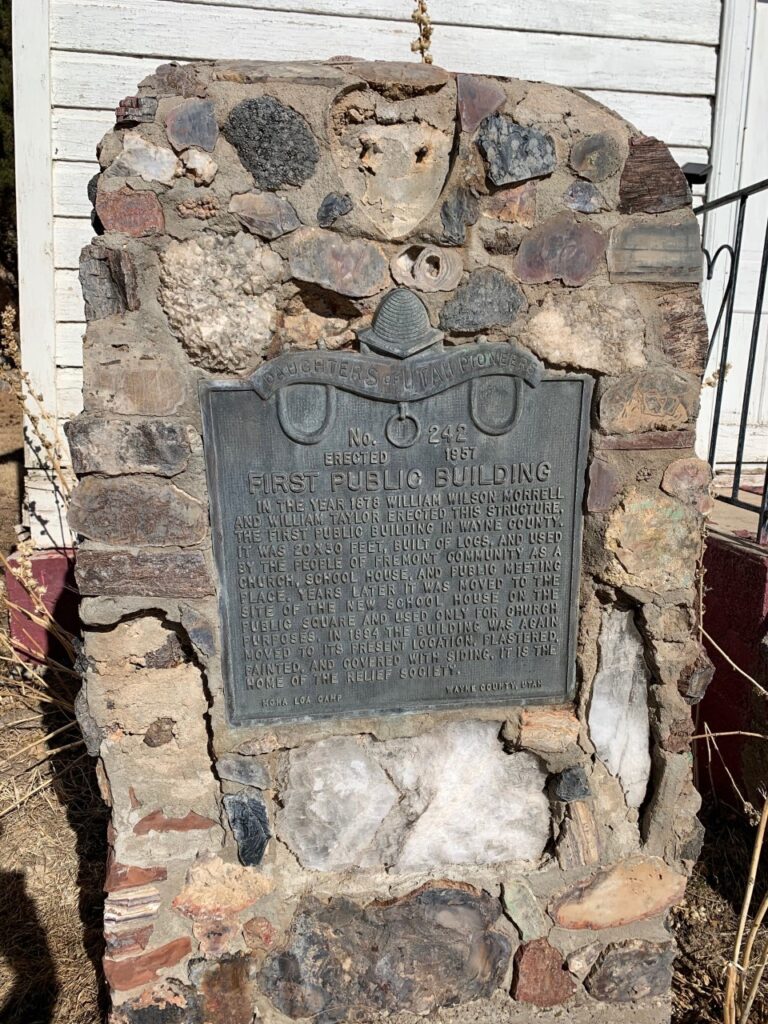Write up by: Parker Wood
Placed by: The Daughters of Utah Pioneers, No. 242. Erected in 1957.
GPS Coordinates: 38° 27.383′ N, 111° 37.319′ W
Pictured above is the plaque and the First Public Building in Fremont, Utah.
Historical Marker Text: In the year 1878 William Wilson Morrell and William Taylor erected this structure, the first public building in Wayne County. It was 20×30 feet, built of logs, and used by the people of Fremont community as a church, school house, and public meeting place. Years later it was moved to the site of the new school house on the public square and used only for church purposes. In 1894 the building was again moved to its present location. Plastered, painted, and covered with siding. It is the home of the Relief Society.
Extended Research:
As a child my grandmother took me and my siblings to Fremont’s First Public Building, since it was important to her that she show us the work they had done on the building. She grew up a block away and attended school, church activities and community events there. But to know the history of the First Public Building in Fremont, Utah, it is important to first understand the histories of the indigenous people who lived there, and the histories of settlers who later colonized land in the 1870s. There were different bands of the Paiutes in the area who were nomadic in nature. They lived in small family bands, hunting and gathering on the land. There are limited sources regarding these bands of Paiute, but historians know that they eventually moved on to other parts of the region as they were driven out by Mormon colonizers. In the cemetery where my grandparents are buried, right next to them there are five Native Americans buried. They have been marked within the last five years by a local mortuary to commemorate their lives. As a child I was never told of the Indigenous people who had lived on the land before my ancestors colonized. It was as if they had just “disappeared.” While there are efforts being made today, the histories of these people may never be told.
Rabbit Valley was a very remote settlement area that encompassed different towns such as Loa, Thurber (now Bicknell), Torrey, Lyman, Fremont, and Teasdale. In most of the towns the Latter-day Saint colonizers established public buildings that served many purposes. Fremont was established in 1876 in the northern end of Rabbit Valley in a very remote part of the Utah Territory. Historian Miriam Murphy noted that Fremont is tucked right up next to the Fishlake Mountains. Rabbit Valley has a very high elevation of roughly 7,000 feet above sea level which is challenging as there is a very short season for crops and other farm goods. The bulk of people have cattle ranches or work for the forest service and other public entities.
Fremont is one of the towns in the county to have a public building. It is also rare that it has stayed intact for so many years, even after it moved in 1894. The foundations for the building itself was built by William Wilson Morrell and William Taylor. William Wilson Morrell is my 3rd great-grandfather and he was a skilled craftsman. As the Latter-day Saint colonizers were building towns he played an important part in the construction of many buildings. He had moved from Ohio to Utah in the 1850s as he had converted to the LDS church. In a nearby historic marker, No. 414 that was placed by the DUP, the first Saw Mill of Rabbit Valley (pictured below) is also remembered. It states that William Wilson Morrell brought a water powered saw mill with him from northern Utah when he moved to Wayne County in 1877. A year later he and William Taylor completed the First Public Building of Fremont. The building was a gathering place of those in the community for church activities, schooling, and other town meetings.[1] My grandmother also mentioned that she attended school in the building as a young girl. My father also remembers going to church activities in the building as child.
The building served multiple purposes. It was a spiritual center where members of the Church of Jesus Christ of Latter-day Saints gathered to worship on Sundays. Many of those same citizens would gather during the week in the same building for public meetings. Children attended school there as well. While Morrell offered his skills in craftsmanship, Taylor owned the land where the building was first located.[2] As the town developed, the building was moved to the town center next to a newly built school so they could both serve as school houses. A new Rock Church was built in 1907 which then took a lot of the activities from the First Public Building. The citizens of the town wanted to make more of a town square which is the reason why they moved the First Public Building to its current location where it served for many years as the Relief Society building, the women’s organization of the Church of Jesus Christ of Latter-day Saints.[3]
The building itself is a very basic construction pattern with a traditional roof and rectangle shape for the foundation. The saw mill that Morrell brought with him from Northern Utah proved to be a very important resource which he used for building the First Public Building along with homes and other buildings in the area. Today the building is not used as much as it was in the past mostly due to its age and the preservation that is taking place.
For Further Reference
Murphy, Miriam B. A History of Wayne County. Salt Lake City, UT: Utah State Historical Society, 1999.
Snow, Anne. Rainbow Views: A History of Wayne County. Springville, UT: ART CITY Publishing Company. 1977.
The First Sawmill Historic Marker, No. 414, Daughters of Utah Pioneers. Fremont, Utah. 1981. Wood, Renon Jenson. Personal Journals regarding family history.
[1] Murphy, Miriam B. A History of Wayne County. Salt Lake City, UT: Utah State Historical Society, 1999, 98.
[2] Murphy, A History of Wayne County, 101.
[3] Snow, Anne. Rainbow Views: A History of Wayne County. Springville, UT: ART CITY Publishing Company. 1977, 145.


